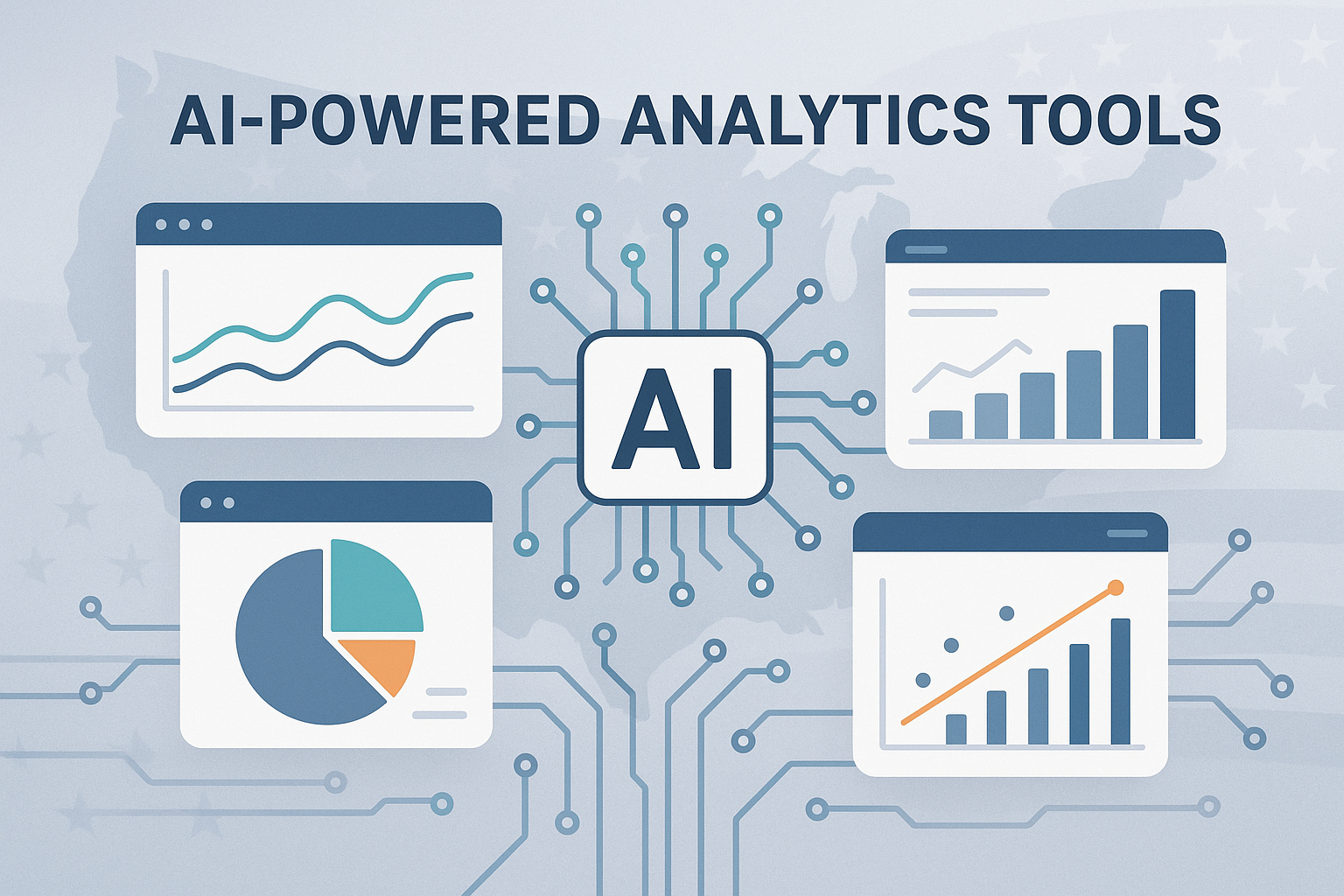
The Ultimate Guide to AI-Powered Analytics Tools in 2025
Unlocking the power of data is no longer a luxury—it’s a necessity for U.S. businesses in 2025. With the explosion of big data, AI-powered analytics tools have become the backbone of decision-making, offering unprecedented insights and automation. In this comprehensive guide, we’ll explore the top solutions, their features, and how to choose the best AI analytics tool for your organization.
What Are AI-Powered Analytics Tools? 🤖📊
AI-powered analytics tools are advanced software platforms that leverage artificial intelligence and machine learning to analyze massive datasets, uncover patterns, predict trends, and automate reporting. Unlike traditional analytics, these tools can:
- Process unstructured data (text, images, audio)
- Deliver real-time insights
- Automate anomaly detection
- Provide predictive and prescriptive analytics
TIP: AI analytics tools are especially valuable for U.S. companies aiming to stay competitive in fast-evolving markets like finance, healthcare, and e-commerce.
Why U.S. Businesses Need AI Analytics Tools in 2025
The Data Explosion in the U.S.
According to the U.S. Bureau of Labor Statistics, data-driven roles are among the fastest-growing in 2025. With over 2.5 quintillion bytes of data generated daily, manual analysis is no longer feasible.
Key Benefits of AI-Powered Analytics Tools
- ✅ Faster Decision-Making: Real-time dashboards and alerts
- ✅ Improved Accuracy: Machine learning reduces human error
- ✅ Cost Savings: Automates repetitive analysis tasks
- ✅ Scalability: Handles growing data volumes effortlessly
Top 10 AI-Powered Analytics Tools for U.S. Businesses (2025 Edition)
Choosing the right tool can be overwhelming. Here’s a ranked list of the best AI analytics platforms for U.S. organizations in 2025, based on features, user reviews, and market presence.
1. Microsoft Power BI with Copilot AI
2. Tableau with Einstein Discovery
3. Google Cloud Looker AI
4. IBM Cognos Analytics with Watson
5. SAS Viya
6. Qlik Sense with AutoML
7. ThoughtSpot Sage
8. Oracle Analytics Cloud
9. Domo AI
10. Sisense Fusion
Side-by-Side Comparison Table
| Rank | Tool Name | AI Features | Best For | Pricing (2025) | U.S. Data Compliance |
|---|---|---|---|---|---|
| 1 | Microsoft Power BI + Copilot | Natural language queries, predictive analytics | Enterprises, SMBs | From $20/user/mo | ✅ |
| 2 | Tableau + Einstein Discovery | Automated insights, ML models | Data visualization | From $70/user/mo | ✅ |
| 3 | Google Cloud Looker AI | Embedded AI, real-time alerts | Cloud-first teams | Custom pricing | ✅ |
| 4 | IBM Cognos + Watson | NLP, anomaly detection | Large enterprises | From $15/user/mo | ✅ |
| 5 | SAS Viya | Advanced ML, forecasting | Regulated industries | Custom pricing | ✅ |
| 6 | Qlik Sense + AutoML | AutoML, associative analytics | Mid-size businesses | From $30/user/mo | ✅ |
| 7 | ThoughtSpot Sage | Search-driven analytics | Self-service BI | From $95/user/mo | ✅ |
| 8 | Oracle Analytics Cloud | AI-powered data prep | Oracle users | From $16/user/mo | ✅ |
| 9 | Domo AI | Automated reporting, alerts | Marketing teams | Custom pricing | ✅ |
| 10 | Sisense Fusion | Embedded analytics, ML | SaaS providers | Custom pricing | ✅ |
How to Choose the Best AI-Powered Analytics Tool for Your Needs
1. Define Your Business Goals
Are you looking for predictive analytics, automated reporting, or real-time dashboards? Clarifying your objectives will narrow down your options.
2. Evaluate Integration Capabilities
Ensure the tool integrates seamlessly with your existing U.S.-based data sources (e.g., Salesforce, AWS, Google Cloud).
3. Prioritize Data Security & Compliance
U.S. regulations like HIPAA, CCPA, and SOX require strict data handling. Choose tools with robust compliance features.
4. Assess Usability and Support
Look for intuitive interfaces and strong U.S.-based customer support.
TIP: Most leading platforms offer free trials or demos—test before you commit!
Real-World Use Cases for AI Analytics Tools in the U.S.
Healthcare 🏥
- Predict patient outcomes
- Detect insurance fraud
- Optimize hospital resource allocation
Retail & E-Commerce 📦
- Personalize customer recommendations
- Forecast demand and inventory
- Analyze customer sentiment from reviews
Finance & Banking 💰
- Detect fraudulent transactions
- Automate credit risk analysis
- Optimize investment portfolios
Sample Code: Integrating AI Analytics with Python
Here’s a simple example of using Python to connect to Microsoft Power BI’s REST API for automated reporting:
import requests
# Replace with your Power BI access token and workspace/report IDs
access_token = 'YOUR_ACCESS_TOKEN'
workspace_id = 'YOUR_WORKSPACE_ID'
report_id = 'YOUR_REPORT_ID'
headers = {
'Authorization': f'Bearer {access_token}',
'Content-Type': 'application/json'
}
url = f'https://api.powerbi.com/v1.0/myorg/groups/{workspace_id}/reports/{report_id}'
response = requests.get(url, headers=headers)
if response.status_code == 200:
print("Report details:", response.json())
else:
print("Error:", response.status_code, response.text)
TIP: Always secure your API tokens and follow best practices for data privacy!
Future Trends: The Evolution of AI Analytics Tools in 2025 and Beyond
- Generative AI for Data Storytelling: Automated narratives and visualizations
- Edge AI Analytics: Real-time insights at the device level
- Explainable AI (XAI): Transparent, auditable models for regulatory compliance
Conclusion: Harness the Power of AI-Powered Analytics Tools in 2025
AI-powered analytics tools are transforming how U.S. businesses operate, innovate, and compete. By choosing the right platform, you can unlock actionable insights, automate complex tasks, and drive growth in 2025 and beyond.